Computational Engineering Mechanics
Computational Engineering Mechanics (CEM) is a multidisciplinary field based on
engineering mechanics, applied mathematics, physics, and computer science. It
focuses on developing and implementing new methods and algorithms to tackle
computationally intensive problems in science and engineering. These
applications range from small-scale parts to complex machines and large-scale
structures. Some examples of these applications would include the design of
gears, vehicles, and buildings, respectively.
CEM is centered around the design and analysis of structures and machines. It
provides essential tools to predict and understand how materials and structures
respond to various conditions. By applying mathematical and physical
principles, engineering mechanics enables engineers to design safe and
efficient structures, such as bridges, buildings, vehicles, and machinery. The
rigorous analysis and modeling techniques in this field ensure that engineered
systems can withstand the loads and stresses encountered during their service
life.
With advancements in computing power and high-performance computing, CEM has
become integral to research in mechanical, materials, automotive, and aerospace
engineering fields. It offers reliable numerical simulations that are efficient
and precise, replacing costly and sometimes impractical experiments.
Injury Biomechanics
The CAVS CEM group’s researchers conduct state-of-the-art injury biomechanics research through both simulations and experiments. One of our primary foci is creating high-fidelity multiscale finite element analysis (FEA) models that include the effects of injury mechanisms at all length scales. To accomplish this, we utilize a combination of simulation methods and experimental methods to investigate biological tissues and injury mechanisms from the nanoscale to macroscale. We also focus on building machine-learning based surrogate models that are used to study a variety of human injury scenarios and allow injury predictions at a much lower computational cost. These capabilities allow us to study many conditions that cannot be tested in living subjects.
Multiscale Traumatic Injury
The CAVS CEM group researchers can perform a variety of finite element
simulations to examine human injury biomechanics. These efforts can include a
variety of tasks, such as material characterization through quasistatic and
dynamic rate experiments, creating simulation meshes from images, and
performing simulations for conditions of interest, such as blasts, impacts, or
vehicular crashes. Our research simulations aid in developing improved
protective devices, understanding injury, and post-injury assessments.
While we can simulate injuries across the body, our group has a particular
focus on traumatic brain injury (TBI) research, including head injuries from
contact sports, blast incidents, and highway accidents. These research efforts
involve multiscale biomechanical experimentation and computational modeling
that assist in TBI diagnostic techniques, injury biomechanics, and
human-centric engineering design. In support of our TBI models, we can perform
multiscale experiments across diverse strain rates and stress states, which can
include tests to obtain material properties for surrogate porcine tissues, in
vitro neuron cell cultures, and in vivo rodent models. The data obtained from
these biomechanical experiments feed into a microstructure-based multiscale
brain constitutive model to capture primary and secondary injuries arising from
TBI more accurately. These models enable scientists to view the impact of
injuries at different length scales and examine the underlying complex damage
mechanisms, allowing a better understanding of these mechanisms.
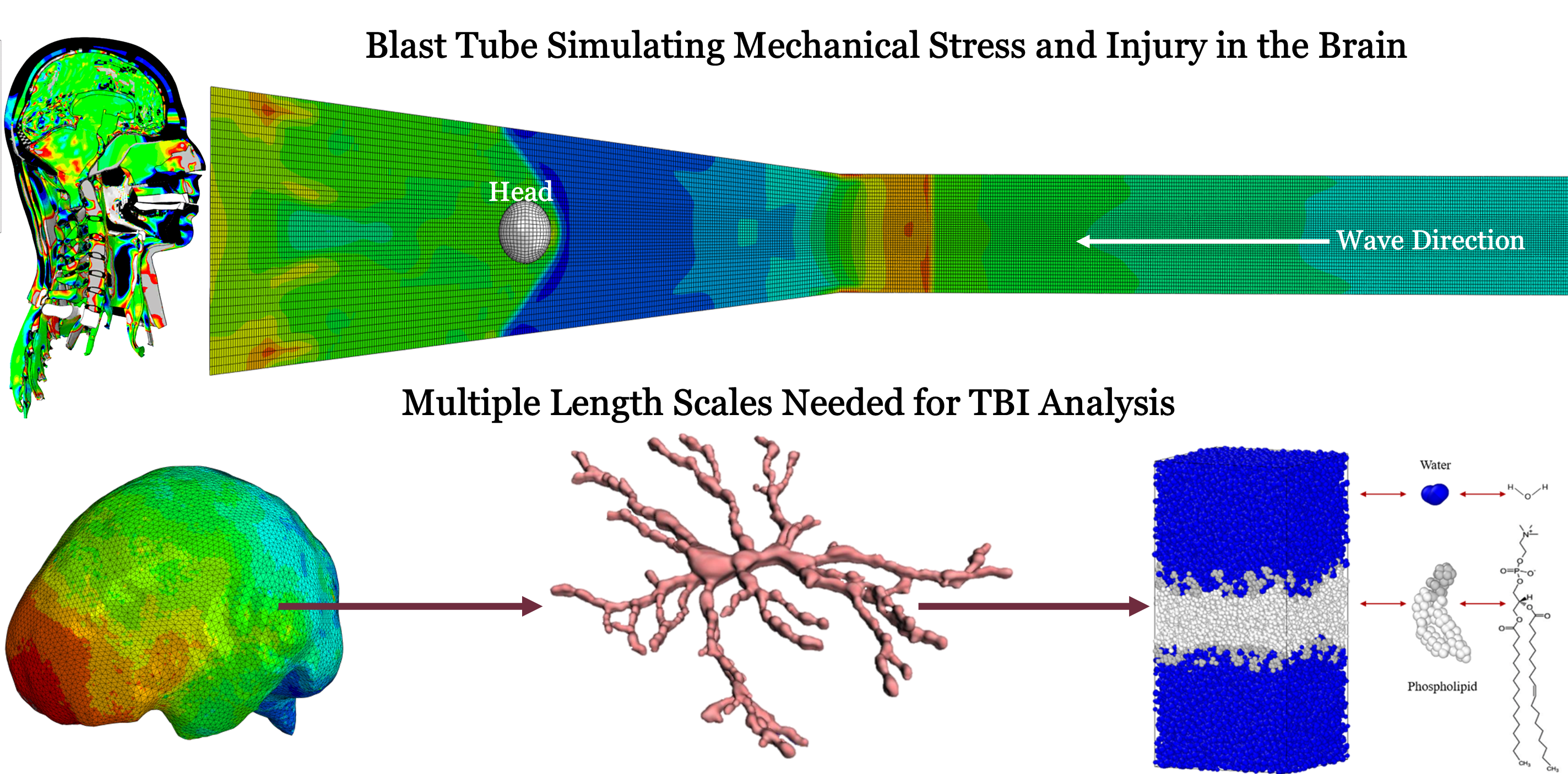
Human Vibration Injury
The CAVS CEM group also focuses on vibration injury, where finite element models are subjected to vibration conditions to analyze the body’s responses to common conditions (e.g., driving a vehicle). These are used to map design spaces for surrogate models that help predict potential injury to known conditions. While this injury is subtle, vibration exposure can result in long-term lower-back discomfort and pain. Modeling this injury type helps guide sitting or standing posture recommendations, vehicle suspension optimizations, and vibration exposure levels. It can also help identify potential issues with a new vehicle designs that can lead to problematic vibration frequencies, such as one that results in premature occupant fatigue.
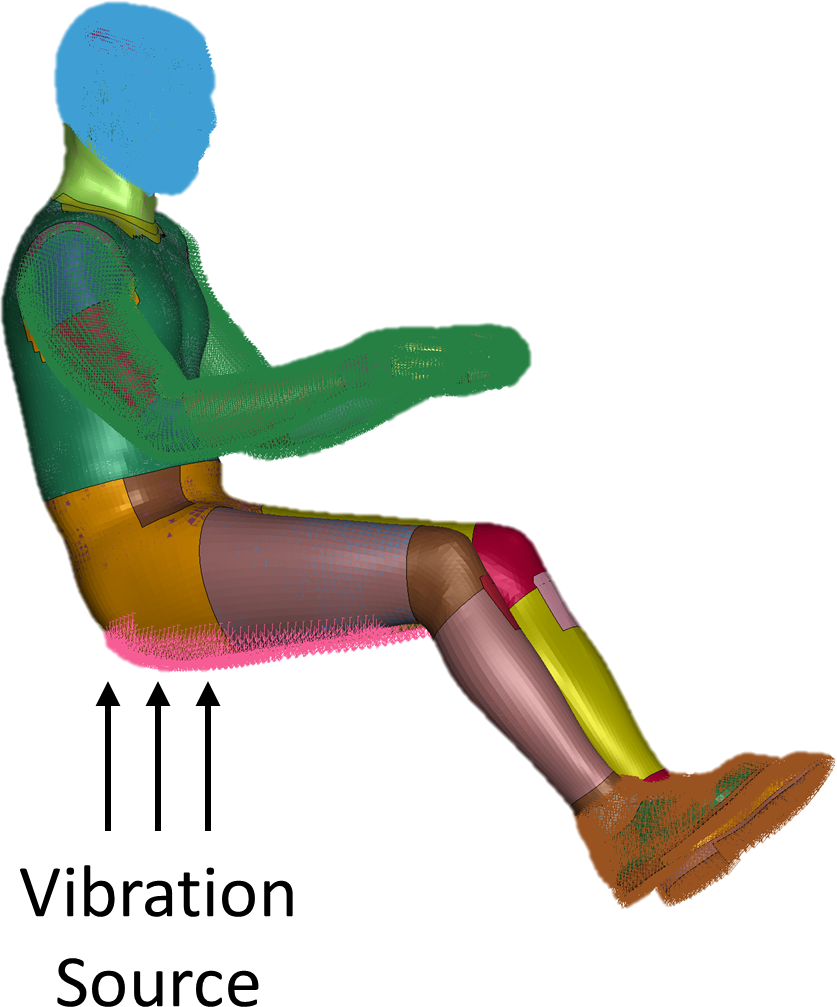
Injury Surrogate Modeling
While our advanced injury models can be used to assess injury risk in scenarios ranging from sports related impact, automotive accidents, and blast related incidents, the time and cost to run these simulations can be quite high. We can use these complex models to recreate injury incidents to generate information that would otherwise be unavailable from field related work, but they may be too expensive or take too long to run for many practical purposes. Often, it makes more sense to create a surrogate (machine-learning) model that captures specific injury types based on the outputs of our high-fidelity injury models being run with a range of boundary condition inputs. These surrogate models can be run at a fraction of the time and cost of a full high-fidelity model while still providing reasonable responses. This combination approach enables generating a robust design space while also providing a way to get near-instant answers regarding injury risk. This fast response time can be critical in time-sensitive problems, and having a pre-trained model can help reduce the cost to design new protective gear.
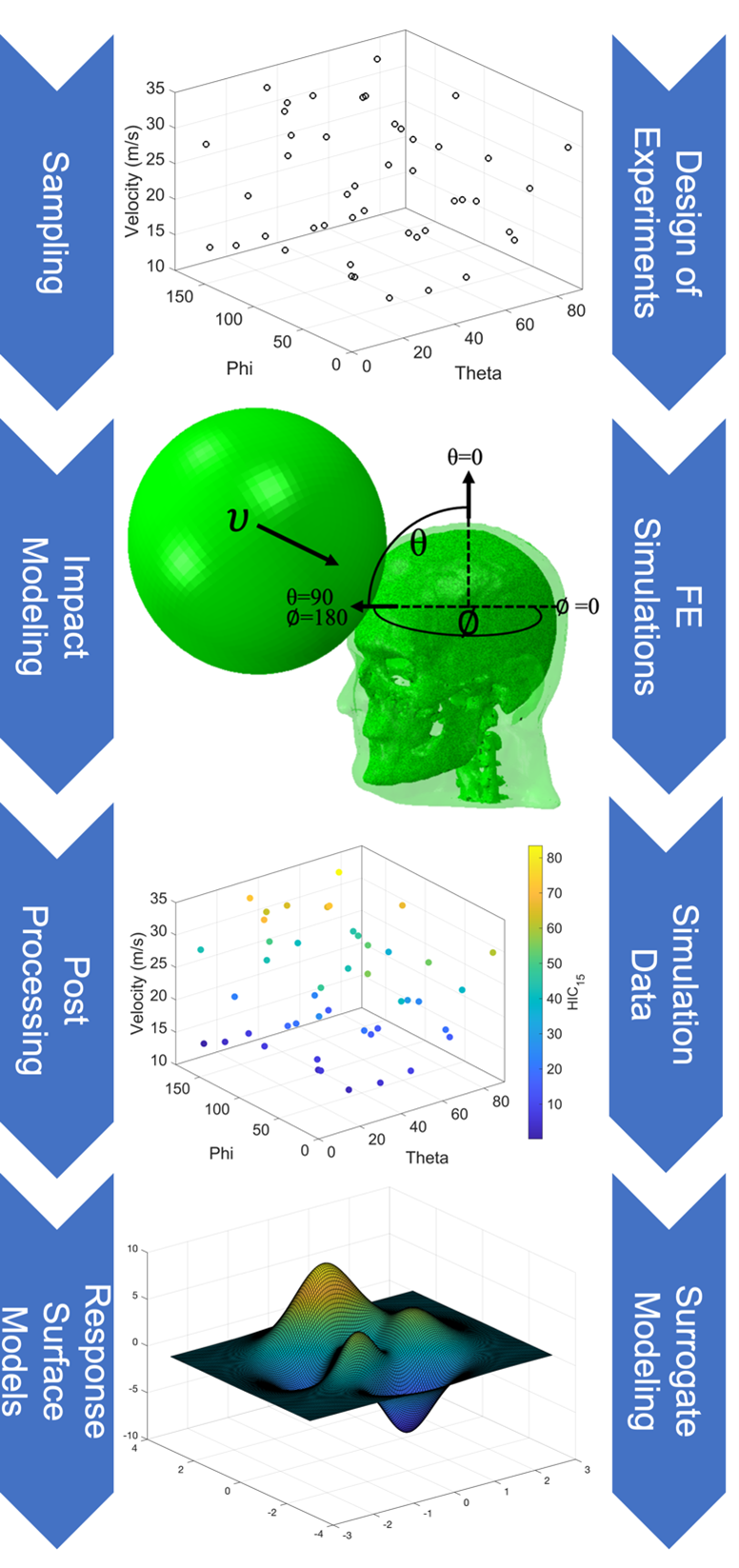
Structural and Material Design
The Computational Engineering Mechanics (CEM) group brings both experimental and computational modeling expertise across multiscale, from atomistic to macro scale to solve problems associated with designing materials and structures. The group facilitates state-of-art computational resources and material research laboratories, advanced sensing, and the imaging center.
Bio-Inspired Design
In nature, creatures exhibit remarkably ingenious hierarchical multi-material designs and construction to perform meticulous functions to sustain lives, all of which are marvels to behold. These features often inspire innovative technologies, specifically within the materials industry. Multi-material hierarchical composite structures, such as those found in the exoskeletons of crustaceans, insects, bird beaks, turtle shells, ram’s horn etc., have inspired the development of novel lightweight materials that are strong and tough. Examples of the research that our group has done is the below:
The endocuticle of an ironclad beetle. (a) An optical micrograph of an oblique cross-section (location depicted in the inset) showing helicoidally stacked fibrous structure, known as the Bouligand structure. Each fiber layer was observed to overlap with the neighboring layers. (b) A zoomed-in image showing the overlapped fibrous regions. (c) A schematic that depicts the extended fibers with a 5%–19% overlap between layers. (d-e) SEM on the cross-section of the fractured samples in the normal direction illustrations of overlapped fibrous regions.
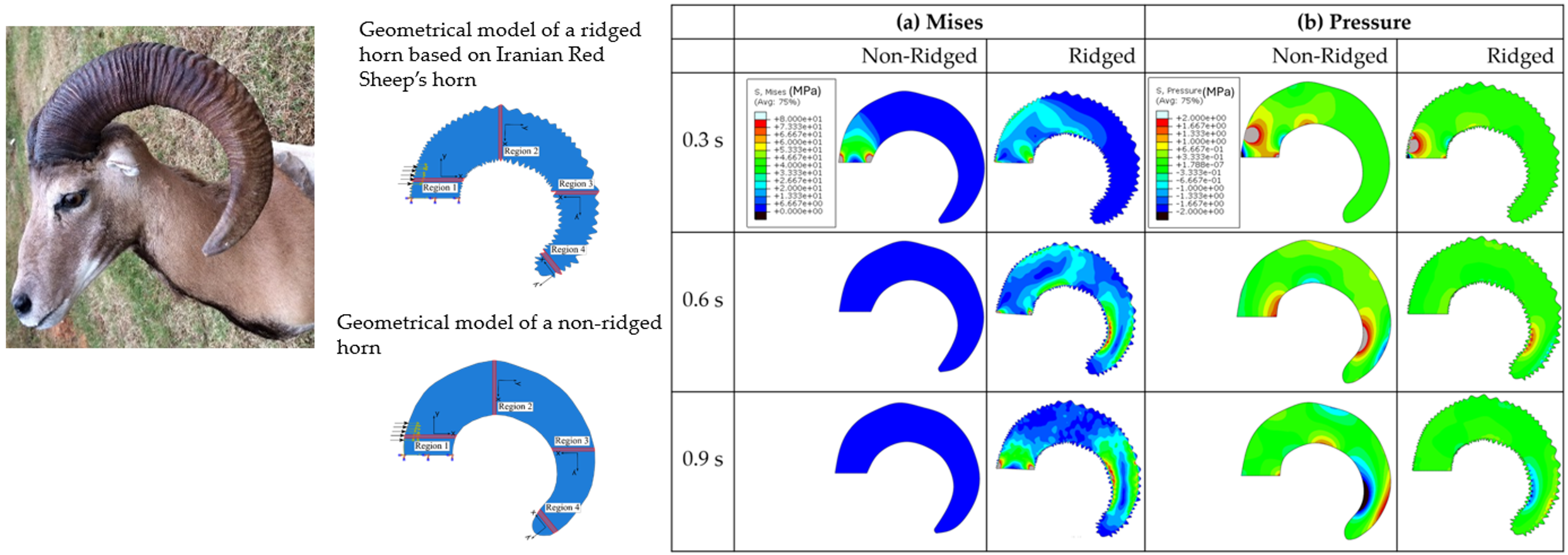
The ridges of ram’s horn play a role in converting normal stress waves to shear stress waves.
Structural Design
Mobile deployment barriers serve critical security needs in stopping vehicle and ballistic impact scenarios and in mitigating blasts. Our researchers are using finite element analysis and surrogate modeling methods to design and optimize rapid deployable structures for ballistic impact and blast mitigation. Using a machine-learning based design optimization, we designed a deployable protection barrier with four objectives of minimizing weight, maximizing the length, maximizing blast resistance, and maximizing impact resistance.
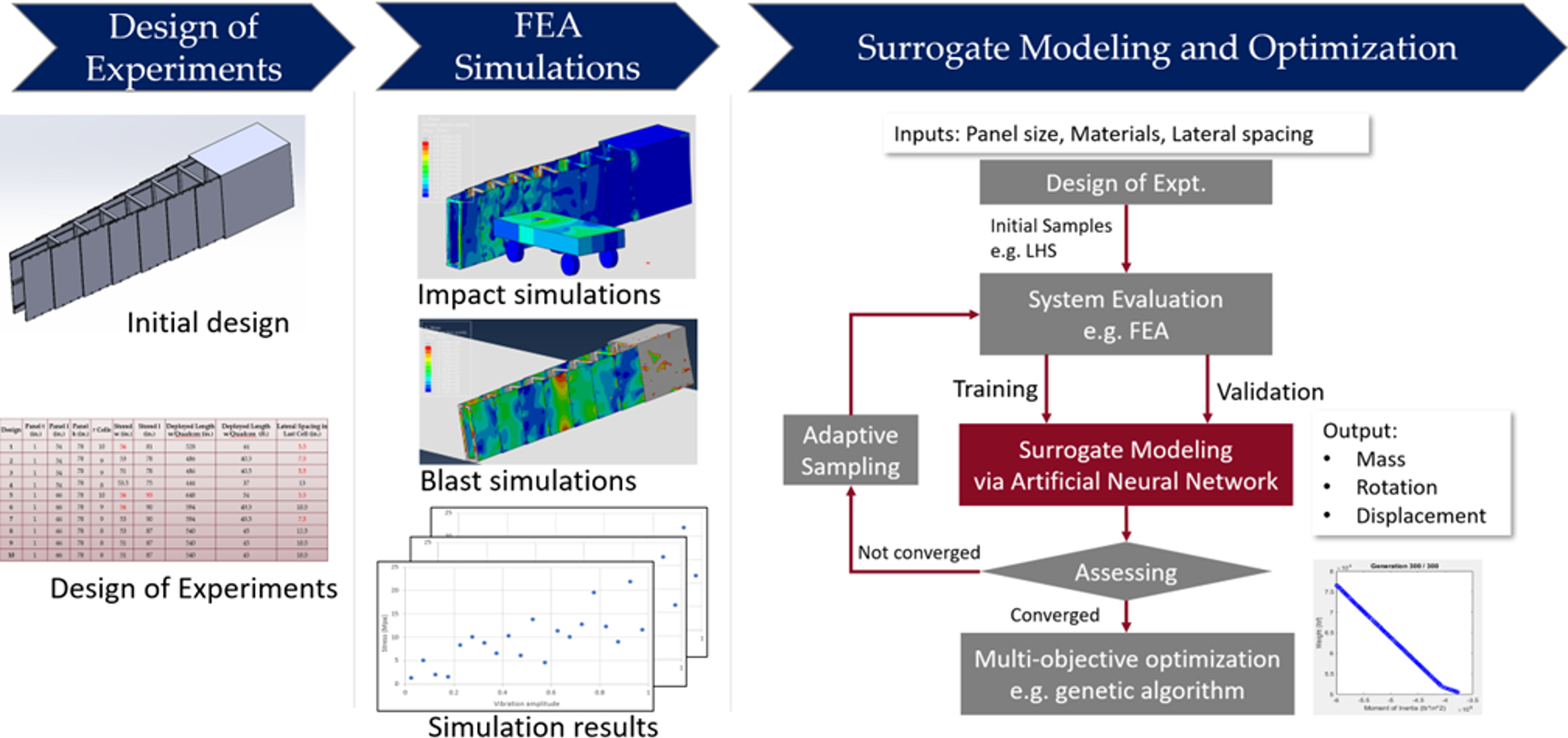
References
- Lee, N., Berthelson, P.R., Nguyen, V., Brinda, A.K., Moser, R.D., Horstemeyer, M.F., Rhee, H. and Prabhu, R.K., 2021. Microstructure and nanomechanical properties of the exoskeleton of an ironclad beetle (Zopherus haldemani). Bioinspiration & Biomimetics, 16(3), p.036005.
- Lee, N., Mun, S., Johnson, K.L. and Horstemeyer, M.F., 2024. The Function of Horn Ridges for Impact Damping. Biomimetics, 9(8), p.506.
Structural Optimization
Our research group is committed to advancing structural optimization by
harnessing advanced computational methods, empowering designers in the
development of innovative and efficient designs across a wide range of
applications. We leverage high-performance computing to simulate complex finite
element models and generate data for tackling challenging engineering problems.
By employing machine learning-based surrogate modeling techniques, including
Artificial Neural Networks (ANN), Response Surface Methods (RSM), and Kriging,
we extract intricate relationships within the data to develop precise
mathematical models. These models are seamlessly integrated with optimization
algorithms, such as NSGA-II, enabling efficient exploration of high-dimensional
design spaces and optimization of structural performance. Our expertise in
simulation, surrogate modeling, and design optimization allows us to quickly
and effectively identify robust, optimal solutions for diverse engineering
challenges.
Our work advances the field of structural optimization by pushing the
boundaries of computational efficiency and accuracy. Through our work, we
demonstrate how cutting-edge methods can address real-world challenges, such as
improving safety, reducing costs, and enhancing performance in diverse
scenarios. These innovations position our research group at the forefront of
modern engineering design, showcasing our ability to develop next-generation
solutions for complex engineering problems.
Workflow of Design Optimization
Material Modeling
Our research group is committed to advancing structural optimization by harnessing advanced computational methods, empowering designers in the development of innovative and efficient designs across a wide range of applications. We leverage high-performance computing to simulate complex finite element models and generate data for tackling challenging engineering problems. By employing machine learning-based surrogate modeling techniques, including Artificial Neural Networks (ANN), Response Surface Methods (RSM), and Kriging, we extract intricate relationships within the data to develop precise mathematical models. These models are seamlessly integrated with optimization algorithms, such as NSGA-II, enabling efficient exploration of high-dimensional design spaces and optimization of structural performance. Our expertise in simulation, surrogate modeling, and design optimization allows us to quickly and effectively identify robust, optimal solutions for diverse engineering challenges. Our work advances the field of structural optimization by pushing the boundaries of computational efficiency and accuracy. Through our work, we demonstrate how cutting-edge methods can address real-world challenges, such as improving safety, reducing costs, and enhancing performance in diverse scenarios. These innovations position our research group at the forefront of modern engineering design, showcasing our ability to develop next-generation solutions for complex engineering problems.
Evolving Microstructural Model of Inelasticity (EMMI)
EMMI is a physically based internal state variable constitutive material model that captures the elastic and viscoplastic properties of ductile metals considering their temperature and rate-dependence. The plasticity model in the EMMI is inspired by dislocation generation, storage, and annihilation and the formation of dislocation sub-structures that are reflected in the two state variables that capture isotropic and kinematic hardening evolution during hardening and recovery during deformation. Isotropic hardening in the EMMI includes hardening, static recovery and dynamic recovery. Kinematic hardening in the EMMI includes hardening and dynamic recovery. Current work on the EMMI material model relates to implementing:
- Texture development effects during complex deformation
- Phase transformation effects on mechanical behavior during changing thermal fields
These current updates are focused on addressing novel additive manufacturing method requirements. One of the important aspects of the EMMI is incorporating adiabatic heating that occur during large and fast deformations to capture thermal softening effects.
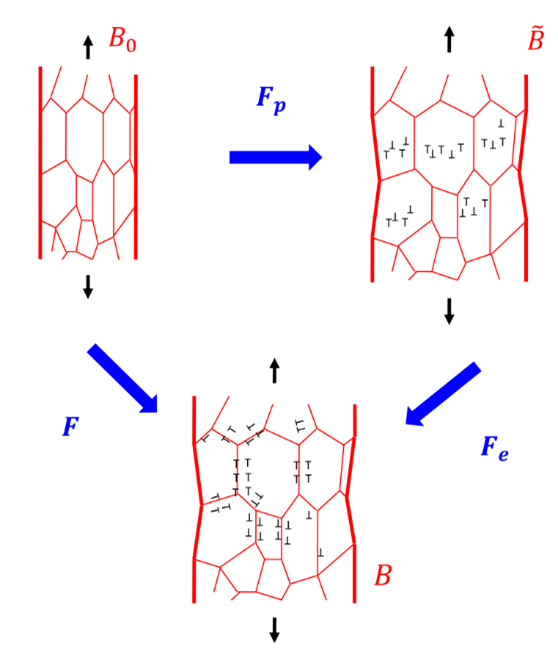
Multiplicative decomposition of the deformation gradient used in the EMMI material model showing dislocation behavior in the reference, intermediate, and current frame of reference.
Rapid Advanced Deposition (RAD)
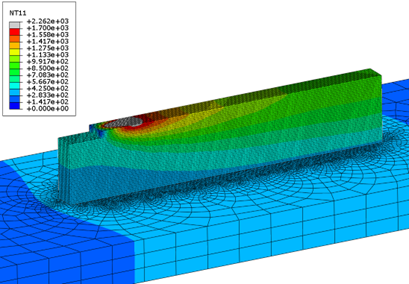
Finite element model of a wire-arc directed energy deposition build.
We develop computational models of additive manufacturing processes. These models are used to:
- Assess the feasibility of a build prior to manufacturing
- Allow for optimization of component design to meet performance criteria
- Fine tuning of manufacturing parameters for optimum mechanical behavior
These approaches allow for more efficient production, reduction of costs, and the production of more reliable parts. We are currently working towards introducing texture evolution effects on the temporally changing mechanical properties of wire arc additively manufactured parts during large complex builds.
Machine Learned Interatomic Potential: Rapid Artificial Neural Networks (RANN)
Machine learning (ML) is transforming material science, particularly in designing and optimizing metal alloys. By leveraging vast datasets and advanced algorithms, ML accelerates material discovery, predicts properties with high accuracy, and optimizes processing techniques. At the Center for Advanced Vehicular Systems (CAVS) at Mississippi State University, we are advancing next-generation alloys for automotive, aerospace, and defense applications using ML. We have developed a rapid artificial neural network (RANN) potential with angular screening to effectively describe covalent and metallic bonding in a reactive manner, significantly reducing the computational complexity of ML interatomic potentials without sacrificing accuracy. For smaller neural networks, this approach matches the speed and accuracy of the modified embedded atom method (MEAM), while larger networks, though slower, achieve chemical accuracy in reproducing training data. Integrated into widely used open-source molecular dynamics (MD) software, RANN ensures numerical accuracy by validating energy conservation, force-pressure consistency, and potential stability in dynamic simulations. Tested on materials like magnesium, iron, and titanium, RANN demonstrates computational efficiency in potential energy curve and phase diagram predictions while maintaining accuracy comparable to slower methods.
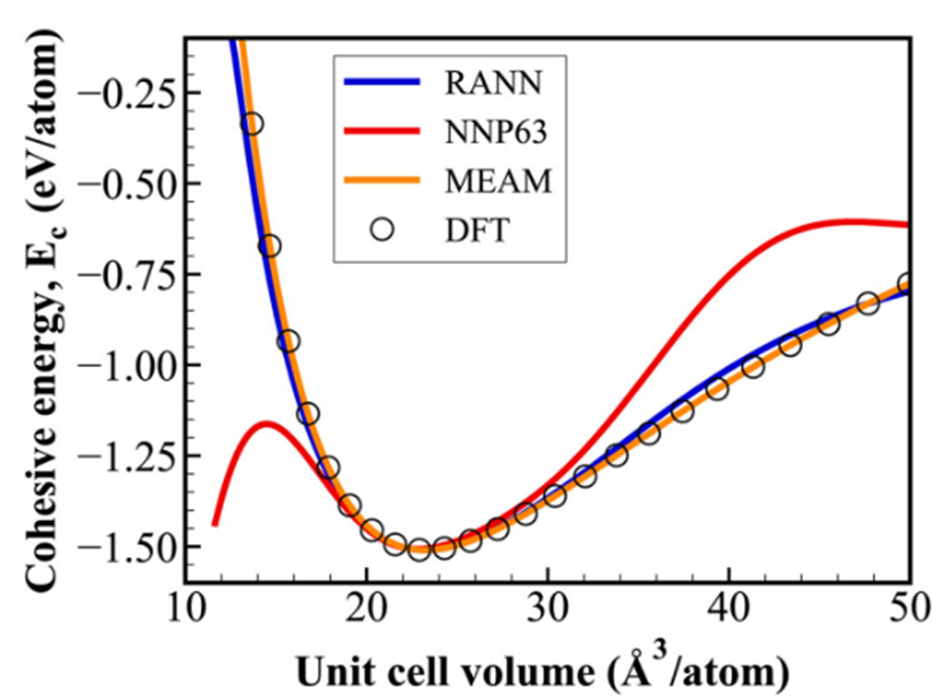
Cohesive energy as a function of atomic volume of HCP unit cell
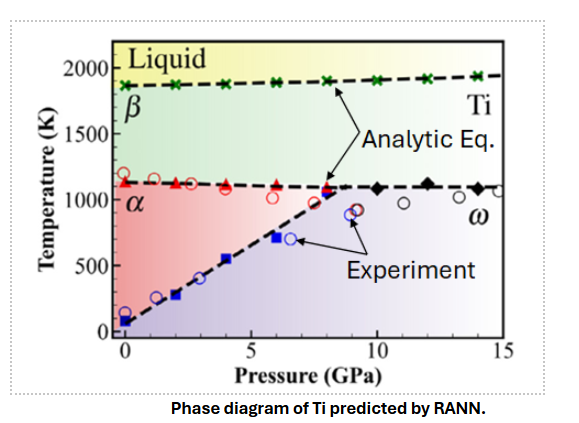
Phase diagram of Ti predicted by RANN
- RANN Project
- LAMMPS Implementation
- RANN Calibration Tool
- Example RANN Parameters
- Dickel, Francis, and Barrett, Computational Materials Science 171 (2020): 109157.
- Nitol, Dickel, and Barrett, Computational Materials Science 188 (2021): 110207.
Multiscale Modeling
The CEM group within the Center for Advanced Vehicular Systems (CAVS) excels in multiscale modeling of materials. Multiscale modeling is a computational approach addressing phenomena across different spatial and temporal scales. This approach integrates information from these scales to provide a comprehensive understanding of complex systems, crucial in fields such as materials science, biology, and engineering.
